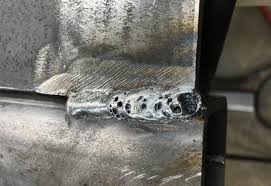What is Porosity in Welding: Common Resources and Effective Solutions
Wiki Article
Comprehending Porosity in Welding: Discovering Causes, Results, and Avoidance Strategies
Porosity in welding is a consistent difficulty that can substantially impact the high quality and stability of welds. As specialists in the welding sector are aware, comprehending the causes, effects, and prevention techniques associated to porosity is essential for accomplishing robust and trusted welds. By diving right into the origin triggers of porosity, analyzing its damaging impacts on weld top quality, and checking out reliable prevention methods, welders can boost their expertise and abilities to produce top quality welds continually. The detailed interaction of factors adding to porosity needs a thorough understanding and a proactive method to make sure successful welding outcomes.Common Root Causes Of Porosity
Contamination, in the form of dust, grease, or corrosion on the welding surface, develops gas pockets when heated up, leading to porosity in the weld. Inappropriate securing occurs when the shielding gas, frequently made use of in processes like MIG and TIG welding, is unable to fully shield the molten weld pool from reacting with the surrounding air, resulting in gas entrapment and succeeding porosity. In addition, insufficient gas protection, usually due to incorrect circulation rates or nozzle positioning, can leave components of the weld unsafe, allowing porosity to form.Effects on Weld Quality
The visibility of porosity in a weld can dramatically compromise the total high quality and stability of the bonded joint. Porosity within a weld creates gaps or cavities that weaken the framework, making it a lot more vulnerable to cracking, rust, and mechanical failure.Furthermore, porosity can hinder the performance of non-destructive testing (NDT) techniques, making it testing to spot other defects or discontinuities within the weld. This can bring about significant safety and security issues, specifically in essential applications where the architectural integrity of the welded elements is extremely important.

Avoidance Techniques Introduction
Offered the destructive effect of porosity on weld quality, reliable prevention techniques are essential to preserving the architectural stability of bonded joints. One of the primary avoidance techniques is complete cleaning of the base products prior to welding. Contaminants such as oil, grease, corrosion, and moisture can add to porosity, so making certain a tidy work surface is important. Proper storage space of welding consumables in completely dry problems is also vital to avoid wetness absorption, which can lead to gas entrapment throughout welding. Additionally, picking the suitable welding specifications, such as voltage, existing, and take a trip rate, can help reduce the risk of porosity formation. Ensuring appropriate protecting gas circulation and insurance coverage is another critical avoidance technique, as not enough gas coverage can cause climatic contamination and porosity. Correct welder training and certification are important for carrying out preventative steps properly and continually. By including these prevention techniques right into welding techniques, the incident of porosity can be significantly minimized, leading to stronger and much more reputable welded joints.Relevance of Appropriate Shielding
Appropriate shielding in welding plays a crucial role in stopping climatic contamination Check This Out and making sure the stability of welded joints. Protecting gases, such as argon, helium, or a mix of both, are frequently made use of to protect the weld swimming pool from reacting with aspects in the air like oxygen and nitrogen. When these responsive components enter into contact with the warm weld pool, they can create porosity, bring about weak welds with decreased mechanical residential or commercial properties.
Inadequate securing can lead to various issues like porosity, spatter, and oxidation, jeopardizing the structural honesty of the bonded joint. Consequently, adhering to correct securing techniques is vital to produce top quality welds with very little problems and ensure the longevity and reliability of the bonded elements (What is Porosity).
Surveillance and Control Approaches
How can welders effectively monitor and manage the welding process to these details guarantee optimal outcomes and stop defects like porosity? By continually checking these variables, welders can determine variances from the suitable conditions and make instant adjustments to protect against porosity formation.
In addition, carrying out proper training programs for welders is essential for monitoring and controlling the welding process efficiently. What is Porosity. Informing welders on the importance of maintaining regular specifications, such as proper gas shielding and travel rate, can aid protect against porosity concerns. Normal assessments and certifications can additionally ensure that welders excel in right here monitoring and managing welding processes
In addition, using automated welding systems can enhance tracking and control capabilities. These systems can specifically control welding specifications, lowering the probability of human mistake and making certain regular weld high quality. By combining sophisticated surveillance technologies, training programs, and automated systems, welders can effectively monitor and manage the welding procedure to decrease porosity flaws and attain premium welds.
Final Thought

Report this wiki page